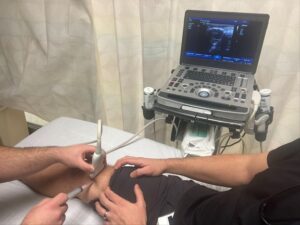Author: Erica Simon, DO, MHA (@E_M_Simon, EM Chief Resident, SAUSHEC, USAF) // Edited by: Alex Koyfman, MD (@EMHighAK, EM Attending Physician, UT Southwestern Medical Center / Parkland Memorial Hospital) and Brit Long, MD (@long_brit, EM Attending Physician, SAUSHEC, USAF)
Welcome to EM@3AM, an emdocs series designed to foster your working knowledge by providing an expedited review of clinical basics. We’ll keep it short, while you keep that EM brain sharp.
As you start shift, the charge nurse informs you of an incoming trauma:
36-year-old male, MCC
Patient found on scene pinned between the highway median and an SUV
Moments later, the trauma bay doors swing open and you hear a man screaming in pain: “My leg!”
As the gurney wheels past, you see a tourniquet applied to the patients left thigh and a paramedic holding an amputated lower extremity in a clear plastic bag.
The patient’s initial VS: BP 122/72, HR 137, T 99.7 Oral, RR 24, SpO2 95% on room air.
What’s the next step in your evaluation and treatment?
Answer: Traumatic Limb Amputation1-4
- Epidemiology:1 According to the National Trauma Databank, 1% of trauma patients sustain a traumatic amputation (MVC is the most common mechanism).
- Evaluation and Treatment:2-4
- Assess and address airway, breathing, and circulation
- Obtain hemostasis:
- First line: Compressive dressings
- Apply tourniquets for life-threatening hemorrhage
- Avoid blind clamping of vessels in the trauma bay => collateral damage to adjacent intact vessels and nerves
- Administer analgesia
- Update tetanus vaccination as appropriate
- Initiate antibiotic therapy:
- First generation cephalosporin + aminoglycoside (if contamination present) + penicillin (if concern for Clostridium, i.e. – wounds containing farm or vegetative material)1
- Perform a complete examination of the injury site:
- Neuro: Evaluate 2-point discrimination
- Vascular: Assess capillary refill and pulses (palpation and Doppler)
- Perform ABIs as indicated
- Soft tissue/bone: evaluate skin, muscle, bone, and tendon injuries => identify exposed bone, gross deformities, and crepitus
- Obtain radiographs of the extremity/joint proximal to the amputation site
- Address the amputated limb:
- Obtain radiographs of the amputated limb
- Irrigate with normal saline => attempt to remove large particulate matter/contaminants
- Wrap in saline-soaked gauze
- Place in a sealed, impermeable bag
- Immerse in ice water
- Obtain hemostasis:
- Considerations for replantation:2-4
- Indications for replantation include: amputation of the thumb or multiple digits, amputation between the palm and distal forearm, amputation proximal to the flexor digitorum superficialis insertion, and pediatric amputations.
- Contraindications to replantation: a hemodynamically unstable patient, a crushed or mangled limb, prolonged warm ischemia time (>12 hours for a digit and > 6 hours for a muscle bearing extremity), prolonged cold ischemia time (>24 hours for a digit and >12 hours for a muscle bearing extremity), severe contamination, an avulsion injury, and multiple co-morbidities (diabetes mellitus, peripheral vascular disease, smokers, etc.).
- Consult as appropriate for replantation determination.
- Assess and address airway, breathing, and circulation
- Pearls:
- Palpate the compartments proximal to the amputation site – compartment syndrome is a frequent occurrence.2
- When performing the H&P, question specifically regarding hand dominance and occupation.
References:
- Barmparas G, Inaba K, Teixeira P, Dubose J, Criscuoli M, et al. Epidemiology of post-traumatic amputation: a National Trauma Databank analysis. Am Surg. 2010; 76(11):1214-1222.
- Solarz M, Thoder J, Rehman S. Management of major traumatic upper extremity amputations. Orthop Clin North Am. 2016; 47(1):127-136.
- Sabapathy SR, Venkatramani H, Bharathi RR, Bhardwaj P. Replantation surgery. J Hand Surg Am. 2011;36(6):1104-10
- Schaider J. Amputation Traumatic/Replantation. In Rosen and Barkin’s 5-Minute Emergency Medicine Consult. 5th ed. Philadelphia, Wolters Kluwer. 2015.
For Additional Reading:
Maximizing ED Management of Amputations







